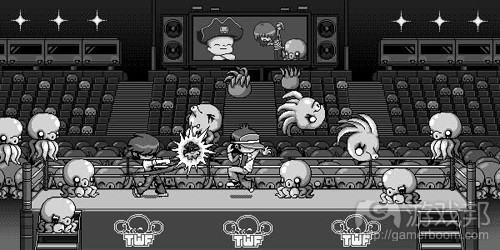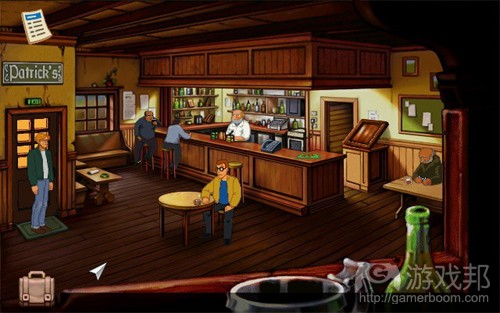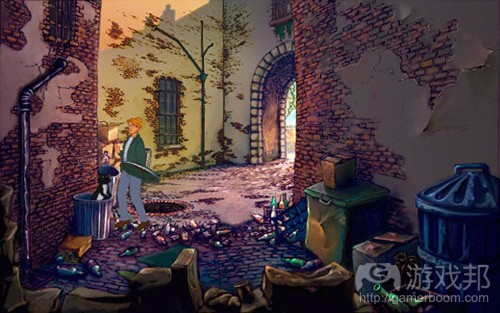游戏设计色彩学之创造不同氛围及场景
作者:Kayleigh Oliver
当代多数游戏都会巧用色彩来吸引其瞄准的用户群体,并传达关于游戏场景的相关信息。但也有一些游戏选择控制游戏色彩,仅采用黑白双色传达视觉形象,也有些游戏通过这种方式创造一种类似老电影的怀旧感。
也有人会运用色彩来降低内容的暴力格调,例如2003与2004年由昆廷·特拉蒂诺导演的电影《杀死比尔》。在一些欧美电影中,运用黑白两色来减少画面暴力感的做法并不鲜见。
全屏效果(Full Screen Effects,简称FSE)
开发者还可以通过运用色彩填充环境,从而让玩家产生一种身临其境之感。
现在多数游戏都会在整个游戏场景中运用明亮色彩,只有当特别强调某个时刻之时,才会转换成黑白基调。在《质量效应》中,当游戏故事主角Shephard失去所有健康值时,所有游戏视窗的颜色都会淡出,强调主角已死的情况。我们之前的文章曾提到灰色、黑色总让人联想到沉闷、无精打采和死气沉沉的氛围,所以这类颜色很适用于表达角色死亡的场景,设计师可运用这类色彩向玩家释放消极信号。
有些游戏会使用血迹飞溅作为FSE,这对玩家来说也蕴含了一种消极意义,而画面呈现鲜红的血迹时更是如此,因为这种情况通常意味着游戏角色正在遇害并丧失健康值。这种FSE在《战争机器》中的运用尤为典型。
随着越来越多游戏问世,设计师愈发难以创造出利用色彩创造出既有新意,又不会让玩家对新系统感到陌生的视觉特效。于是有些游戏就借鉴其竞争对手的做法,重复使用玩家容易理解的特效。这样玩家会更快适应这种特效,而设计师则可由此分散出更多精力设计游戏的新功能。
吸引玩家注意力
设计师还可通过色彩为玩家指出游戏的特定内容,或者强调游戏视窗、HUD或菜单系统中含有特殊信息的对象。
在菜单系统中,更明亮的颜色通常用于指向刚刚选择的对象,提醒玩家自己正选择的内容。而其他选项在此时通常以更暗的颜色显(游戏邦注:或者与游戏主色调相同的色彩)告知玩家这些属于他们暂时无需注意的选项。
有些游戏的视窗也会使用更明亮色彩的物体吸引玩家注意力,虽然这种突出彩色物体的方法在一定程度上很管用,但由于玩家看到这种视觉元素,就会意识到自己是在玩游戏,所以它也会产生削弱玩家沉浸感的副作用。与此同时,这种做法也会对游戏的难度造成影响,因为它会指出游戏的关键环节,让游戏中的谜题更易为玩家所破解。
现在有许多游戏并不主张为玩家特别指出某项物品,但会在屏幕上显示GUI按钮,告知玩家如何获取道具的信息,并通过这种方式为其指出道具所在。有些游戏只有在玩家走到一定距离时才会突出其寻找的物品,让他们快速获取道具,避免因其他抢眼的道具而分心。
在2D游戏中,开发者为了区分背景和前景,通常也会在不同区域采用暗色和亮色来达到这一效果。背景一般情况下会采用暗色元素,而前景及其物品通常是更亮的色调。但有时候也有游戏会将两种做法对调以达到同样的效果(如下图《断剑:圣堂武士之谜》所示)。
总之,我们有多种运用色彩的方法来转移或吸引玩家注意力,创建不同氛围或向玩家传达信息,你只需要找到最合适的色彩运用方法,就有可能为自己的游戏加分增色。
游戏邦注:原文发表于2010年3月20日,所涉事件及数据以当时为准。(本文为游戏邦/gamerboom.com编译,拒绝任何不保留版权的转载,如需转载请联系:游戏邦)
Colour within Game Design: Creating Different Atmospheres
Black and white Vs Colour
The majority of current generation console games use colour to attract their chosen demographic and convey the type of environment that their game is based within. Although using colour can convey a lot of information to the player just by looking at it, some games chose to restrict their colour palletes to black and white only. Some games do this to create a more old-fashioned feel to the game like in old films before colour crept into every type of media we have.
Some may do this to lower the feel of violence as was allegedly done within the 2003 and 2004 film Kill Bill by Quentin Tarantino. It was thought that the goriest fight scenes in American and Europe releases of the film were portrayed in black and white to reduce the level of violence within those scenes.
The Youtube clip below shows a video of Pirate Baby’s Cabana Battle Street Fight that could be considered quite violent for some. Be advised that if you watch the video you may be exposed to scenes of violence.
Full Screen Effects (FSE)
Using colour can immediately fill an environment with feeling that can draw the player into the correct frame of mind for that game.
Most games nowadays rely on bright colours throughout the entire game and only switch to black and white scenes to emphasise moments within the game. In Mass Effect when the main character Shephard loses health all of the colour drains out of the game window to emphasise that the character is dead. As discussed in the previous post, colours like grey and black are associated with dull, drained and lifeless feelings so using these colours at the point of death of a character are very appropriate as the designers want the player to know that something negative has occured.
Some games use blood splatters as their FSE. Again this carries a negative meaning to the player especially if the blood is coloured bright red as they will see that they are taking damage and that their health is being reduced. This type of FSE is used in Gears of War (shown below).
The Youtube clip below shows a video of Gears of War that could be considered quite violent for some. Be advised that if you watch the video you may be exposed to scenes of violence.
As more and more games emerge it can be difficult for designers to come up with new ways of creating visual effects with colour that are new but that also won’t alienate or confuse players to this new system. Some games have re-used the effects that players find easy to understand from their competition. By making these new games use the same effects with colour, players will get accustomed to these effects so designers can focus more on delivering instructions on new features for their game.
Drawing Attention
Colour is also used to draw attention to specific aspects of the game or important information by highlighting objects in the game window, the HUD or the menus system.
In menu systems, brighter colours are used around the currently selected option to make the player aware of what they will be choosing. The other options are usually coloured in dark colours (or something in keeping with the colour scheme of the game) to draw the players attention away from these options.
Using brighter colours on objects to attract the players attention has also been used in the game window within some games, mainly older titles. Although this is an effective way of drawing the players attention by highlighting the object with a colour that will stand out from the background environment, doing this also makes the player more aware that they are playing a game and are less immersed in the game world. This also affects the difficulty of the game as pointing out crucial parts of the game will make game puzzles easier for most players. See how many interactable items you can see within the screenshot below from Broken Sword: Shadow of the Templars (SotT).
Many games nowadays do not highlight the object but show GUI buttons on screen to provide the player with information of how to acquire the item and highlighting it to them. Some just highlight the object when the player is within a certain distance so the player can acquire it quickly and are less distracted by an item that is constantly attracting the players attention.
In 2D games to differentiate between the background and the foreground, dark and light colours can be used in these areas. The background is usually coloured in darker shades and the foreground and objects that the player can interact with are coloured in lighter, brighter shades. Although this may be inverted as shown in a scene from Broken Sword: SotT below.
There are a multitude of ways that colours can be used within games to deflect or direct a players attention, to create different atmospheres or reinforce a message to the player. Make sure that which ever way you use colour within your game designs that they are effective and complimentary to your game.(source:takeinitiative)
上一篇:列举让玩家反感的5项游戏设计功能











































